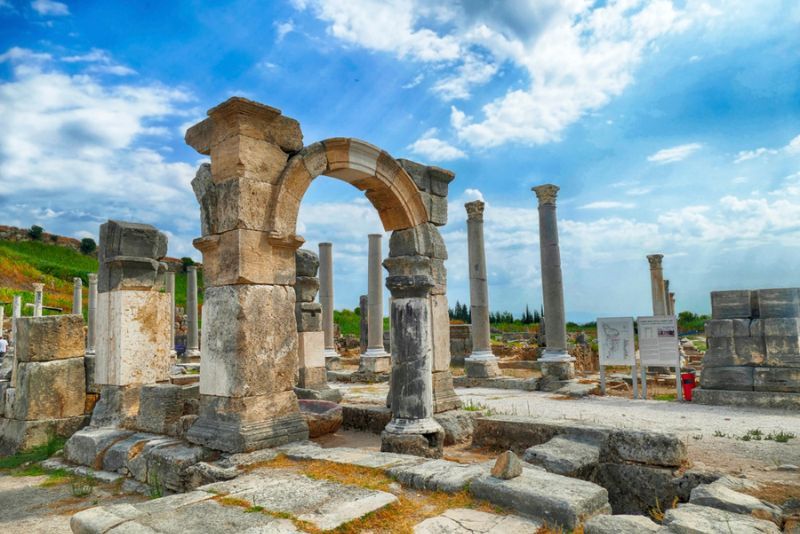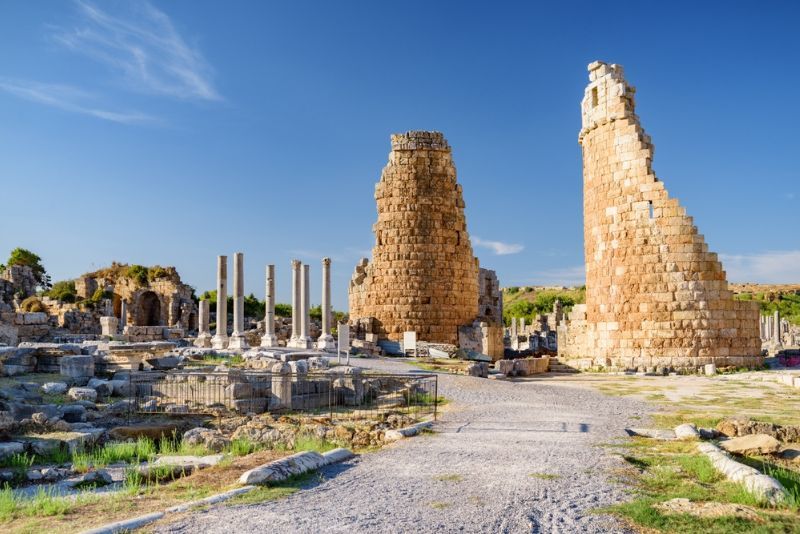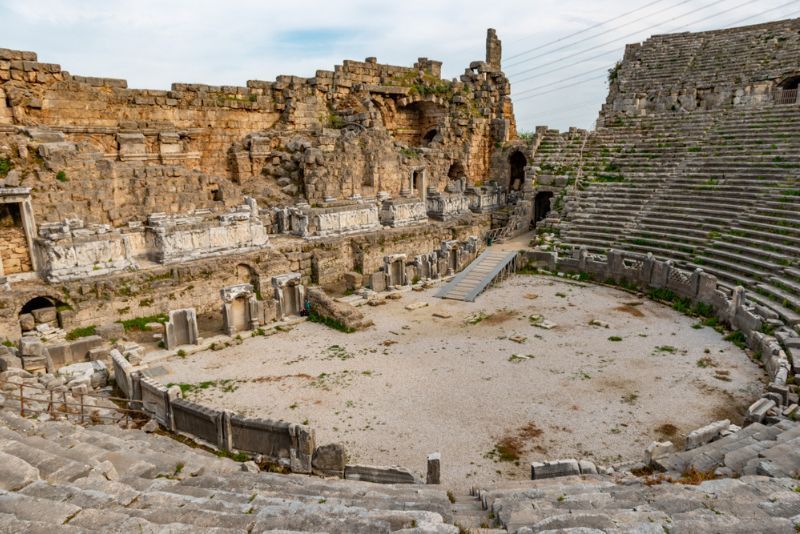Perge: Day Trips and Tours from Antalya
Well over 3,000 years old, Perge is one of southern Turkey’s most historically-important cities and was once the capital of the Pamphylia region. Originally built as an ancient Lycian settlement around 1500 B.C., Perge is filled with beautiful Roman and Hellenistic ruins. Joining a Perge day trip from Antalya is a great way to get out of the city and enjoy an authentic experience exploring one of the region’s oldest and most famous historic sites. A trip to southern Turkey would be incomplete without taking the time to learn more about the area’s fascinating past.
Read Full Guide
Well over 3,000 years old, Perge is one of southern Turkey’s most historically-important cities and was once the capital of the Pamphylia region. Originally built as an ancient Lycian settlement around 1500 B.C., Perge is filled with beautiful Roman and Hellenistic ruins. Joining a Perge day trip from Antalya is a great way to get out of the city and enjoy an authentic experience exploring one of the region’s oldest and most famous historic sites. A trip to southern Turkey would be incomplete without taking the time to learn more about the area’s fascinating past.
Read Full Guide

(0/24) checking Musement...
Well over 3,000 years old, Perge is one of southern Turkey’s most historically-important cities and was once the capital of the Pamphylia region. Originally built as an ancient Lycian settlement around 1500 B.C., Perge is filled with beautiful Roman and Hellenistic ruins.
Joining a Perge day trip from Antalya is a great way to get out of the city and enjoy an authentic experience exploring one of the region’s oldest and most famous historic sites. A trip to southern Turkey would be incomplete without taking the time to learn more about the area’s fascinating past.

Here's all you need to know about Perge, one of the most exciting day trips from Antalya.
How to get to Perge from Antalya?
Perge is located on a coastal plain between two rivers in southern Turkey and is roughly 16 kilometers northeast of the city of Antalya.
From Antalya to Perge by car
Driving from Antalya to Perge should only take around 25 minutes and the route is simple. All you need to do is drive in a northeasterly direction on the D400, passing the airport along the way. After around 8 kilometers, you’ll turn left onto Atatürk Cd and follow the signs to Perge.
From Antalya to Perge by tram
When traveling on public transport, you can take the T1B tram from Antalya and get off at the Asku stop. From Asku, you can either get a taxi or walk to the ancient city of Perge as the distance between Perge and Aksu is only around 2 kilometers.
The entire journey should take between 30 and 50 minutes, depending on whether you choose to take a taxi or walk for the last leg of the trip.
Guided tour to Perge from Antalya
Allow a professional tour guide to take care of all your travel plans, including hotel transfers when you join a guided tour to Perge from Antalya. You’ll also get to see more of southern Turkey’s historical landmarks, as most tours are full-day excursions, lasting around 8 hours.
How much does the entrance ticket to Perge cost?
Entrance tickets to Perge cost TRY200 (US$10) per person. With this ticket, you’ll be able to see all of Perge’s historical sites.
What is the typical itinerary?
Most Perge day trips from Antalya begin in the morning at around 8:30 AM, when you’ll receive a complimentary hotel pickup. Once you have met your tour guide and group, you’ll make your way to Perge in a private vehicle.
Once you arrive, your professional guide will show you Perge’s top sites, including the temple, the fountain, the stadium and the thermal baths. You’ll get to explore on your own, take photos and simply relax, taking in the incredible atmosphere.
Before you head back to your accommodation in Antalya, you’ll most likely visit a few of the region’s other historical sites, including Aspendos, Side and even nearby waterfalls.
What kinds of tours are available to go to Perge?

Guided tour to Perge plus Side and Aspendos from Antalya
Group excursions to Perge, Side and Aspendos are the most popular types of tours available as they provide an affordable yet enjoyable way to experience southern Turkey’s ancient cities. As there will be other tour participants, you’ll get the chance to meet new people.
Private tour to Perge plus Side and Aspendos from Antalya
Private tours allow you to maximize your time in Perge, Side and Aspendos as your guide can cater to your group’s specific needs. Some of these private tours may also include a visit to the Manavgat Waterfalls. You’ll have more opportunities to ask questions and may also be able to create a customized itinerary.
Virtual reality tour of Perge
See what Perge may have looked like thousands of years ago when you choose a virtual reality tour that makes use of cutting-edge VR headsets. This fully immersive experience is available to groups of up to 3 participants.
How much does a day trip to Perge from Antalya cost?
Virtual reality tours of Perge cost just US$35 per person, but you’ll need to make your own way to the ancient city, where you’ll meet your guide. Group sizes are limited to 3 people per tour.
Guided tours to Perge from Antalya, with itineraries that also include Side and Aspendos, typically cost around US$60 or US$70 per person and are inclusive of hotel transfers and entrance tickets.
Private Perge day trips from Antalya usually cost approximately US$180 per person, or US$600 for a tour that can cater to up to 4 people.
What will you see and do?

Perge Theater
Perge’s Greco-Roman theater can be found near the entrance of the ancient city. It is one of the largest ancient amphitheaters, as it was designed to accommodate as many as 15,000 spectators. The theater gates are intricately decorated, as is the theater’s stage.
Perge Stadium
Perge Stadium is in near-perfect condition and is one of the best-preserved stadiums of antiquity. The stadium was designed to seat roughly 12,000 people and was used to host a variety of games popularized by the Romans.
Fountains
There are two monumental fountains in Perge, one of which can be found near the entrance and was built in honor of Emperor Septimius Severus. The other fountain was dedicated to Emperor Hadrian and can be found at the end of the column street.
Thermal Baths
Perge’s famous thermal baths were built sometime in the 2nd century. Complete with a courtyard, an underground heating system, various rooms, statues and columns —the thermal baths emit an atmosphere of old-world grandeur.
What are the opening times?
The ancient city of Perge is open daily from 8 AM until 8 PM, with the ticket office closing at 7:30 PM.
When is the best time to visit Perge?

The best time to visit Perge is in the spring or fall months, from April to June or September to November. These periods offer moderate temperatures, fewer crowds and an opportunity to appreciate the historical sites in a more comfortable and enjoyable setting.
The summer months, July and August, can be extremely hot and crowded, while winter, although less crowded, might have unpredictable weather conditions.
Travel tips
- Try to get to Perge early to avoid the heat of the day and larger tourist crowds. Remember that it can get quite hot, especially in the summer, so it's better to start your exploration in the cooler morning hours.
- Be sure to wear comfortable walking shoes as you will be walking a lot on uneven terrain.
- Even in spring and autumn, the sun can be strong and there isn't a lot of shade in the site. Ensure you have water to stay hydrated, wear sunscreen and consider bringing a hat or umbrella for added protection.
- Don't miss out on trying the local cuisine. There are various restaurants in Antalya offering traditional Turkish dishes, which could be a perfect way to end your day trip in Perge.

